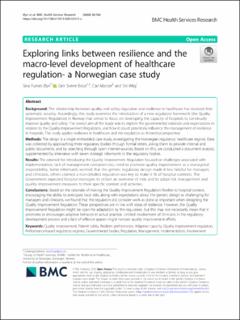| dc.contributor.author | Øyri, Sina Furnes | |
| dc.contributor.author | Braut, Geir Sverre | |
| dc.contributor.author | Macrae, Carl James | |
| dc.contributor.author | Wiig, Siri | |
| dc.date.accessioned | 2020-10-13T13:16:25Z | |
| dc.date.available | 2020-10-13T13:16:25Z | |
| dc.date.created | 2020-08-18T14:46:17Z | |
| dc.date.issued | 2020-08 | |
| dc.identifier.citation | Øyri, S.F., Braut,G.S., Macrae, C. & Wiig, S. (2020) Exploring links between resilience and the macro-level development of healthcare regulation- a Norwegian case study. BMC Health Services Research, 20. https://doi.org/10.1186/s12913-020-05513-x | en_US |
| dc.identifier.uri | https://hdl.handle.net/11250/2682508 | |
| dc.description.abstract | Background
The relationship between quality and safety regulation and resilience in healthcare has received little systematic scrutiny. Accordingly, this study examines the introduction of a new regulatory framework (the Quality Improvement Regulation) in Norway that aimed to focus on developing the capacity of hospitals to continually improve quality and safety. The overall aim of the study was to explore the governmental rationale and expectations in relation to the Quality Improvement Regulation, and how it could potentially influence the management of resilience in hospitals. The study applies resilience in healthcare and risk regulation as theoretical perspectives.
Methods
The design is a single embedded case study, investigating the Norwegian regulatory healthcare regime. Data was collected by approaching three regulatory bodies through formal letters, asking them to provide internal and public documents, and by searching through open Internet-sources. Based on this, we conducted a document analysis, supplemented by interviews with seven strategic informants in the regulatory bodies.
Results
The rationale for introducing the Quality Improvement Regulation focused on challenges associated with implementation, lack of management competencies; need to promote quality improvement as a managerial responsibility. Some informants worried that the generic regulatory design made it less helpful for managers and clinicians, others claimed a non-detailed regulation was key to make it fit all hospital-contexts. The Government expected hospital managers to obtain an overview of risks and to adapt risk management and quality improvement measures to their specific context and activities.
Conclusions
Based on the rationale of making the Quality Improvement Regulation flexible to hospital context, encouraging the ability to anticipate local risks, along with expectations about the generic design as challenging for managers and clinicians, we found that the regulators did consider work as done as important when designing the Quality Improvement Regulation. These perspectives are in line with ideas of resilience. However, the Quality Improvement Regulation might be open for adaptation by the regulatees, but this may not necessarily mean that it promotes or encourages adaptive behavior in actual practice. Limited involvement of clinicians in the regulatory development process and a lack of reflexive spaces might hamper quality improvement efforts. | en_US |
| dc.language.iso | eng | en_US |
| dc.publisher | BioMed Central | en_US |
| dc.rights | Navngivelse 4.0 Internasjonal | * |
| dc.rights.uri | http://creativecommons.org/licenses/by/4.0/deed.no | * |
| dc.subject | kvalitet | en_US |
| dc.subject | sikkerhet | en_US |
| dc.subject | helsefag | en_US |
| dc.subject | resiliens | en_US |
| dc.title | Exploring links between resilience and the macro-level development of healthcare regulation- a Norwegian case study | en_US |
| dc.type | Peer reviewed | en_US |
| dc.type | Journal article | en_US |
| dc.description.version | publishedVersion | en_US |
| dc.rights.holder | © The Author(s). | en_US |
| dc.subject.nsi | VDP::Medisinske Fag: 700 | en_US |
| dc.source.volume | 20 | en_US |
| dc.source.journal | BMC Health Services Research | en_US |
| dc.source.issue | 762 | en_US |
| dc.identifier.doi | https://doi.org/10.1186/s12913-020-05513-x | |
| dc.identifier.cristin | 1823872 | |
| cristin.ispublished | true | |
| cristin.fulltext | original | |
| cristin.qualitycode | 2 | |

